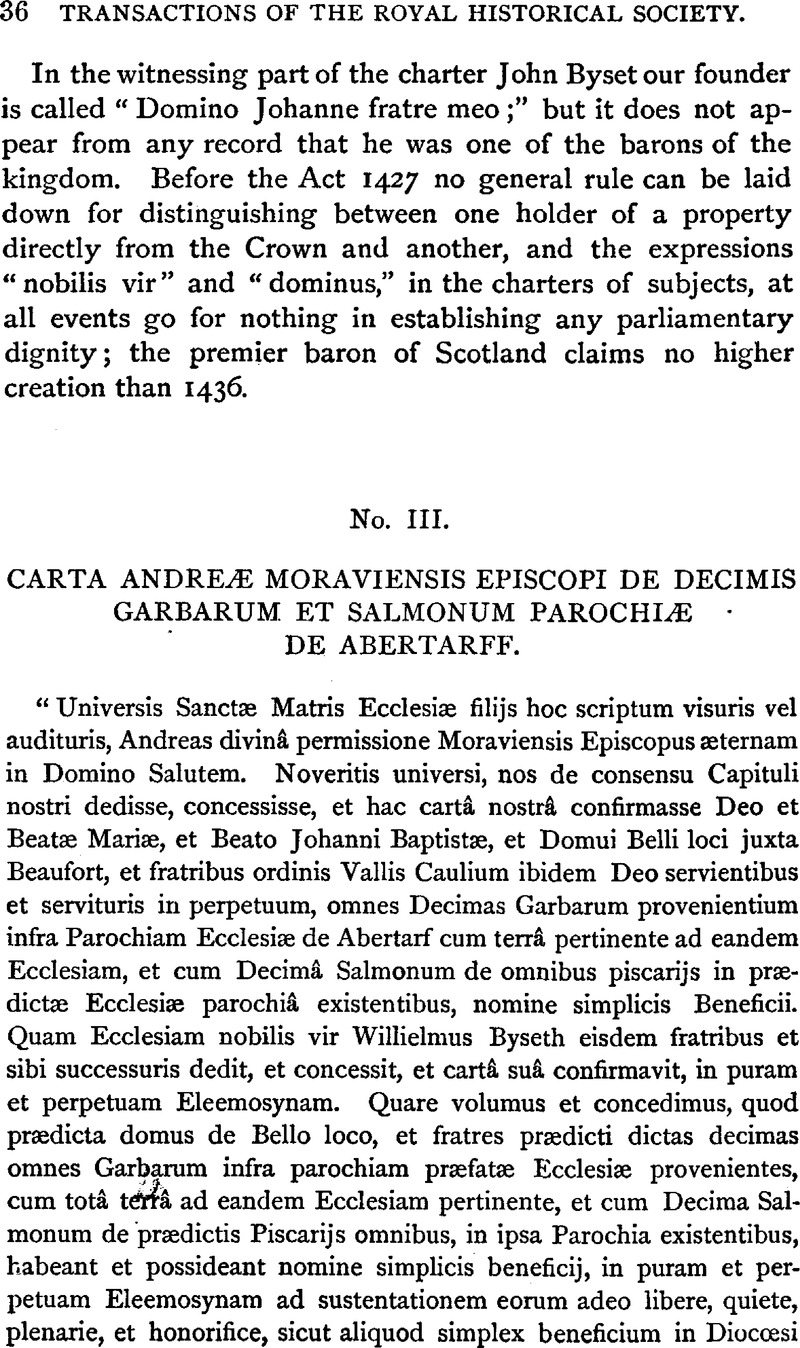No CrossRef data available.
Article contents
No. III. Carta Andreæ Moraviensis Episcopi de Decimis Garbarum et Salmonum Parochiæ de Abertarff
Published online by Cambridge University Press: 12 February 2009
Abstract

- Type
- Historical Notices and Charters of the Priory of Beauly
- Information
- Copyright
- Copyright © Royal Historical Society 1876
References
page 38 note * Chart. Dunfermline, fol. 23.
page 38 note † “The canonists divided benefices into simple and mixed. The first sort lays no obligation but to read prayers, sing, etc.; such kind of beneficiaries are canons, chaplains, chanters. The second is charged with the cure of souls, the guidance and direction of consciences, etc., such as rectories, vicarages, etc.” (Hook's Church Dictionary, art. “Benefices”).
page 38 note ‡ Coke, Second Institute, cap. 17.
page 38 note § Turner, Hudson, Domestic Architecture of England, vol. i., p. 59Google Scholar.
page 39 note * Reg. Moray.
page 40 note * Freeman's Lectures on Wells, and Proceedings of Somerset Archæolog. Soc. 1873.
page 41 note * Kennet's Parochial Antiquities, 234.
page 41 note † “Decanus ruralis” is the title of Adam Gobinot in the Inquisition touching the chapel of Kilravock, A.D. 1343 (Family of Kilravock, p.117).
page 41 note ‡ Mr Stevenson, in his edition of the Chronicle for the Bannatyne Club, inserts dicti Willielmi; but I have been informed since writing the text, that in the MS. from which the Bannatyne edition is printed it is “W.,” that is, Walteri.
page 42 note * This expression, “nefandissimus proditor,” is used by John of Peterborough, and the use of it serves to show that John wrote after the Chronicle of Melrose was compiled, and clears up the question as to whether this John was John de Caleto, who was abbot 1250–62, or John Deeping, who was abbot in 1410–39 —“a mystery,” SirHardy, Thomas writes, “I am not able to solve” (Catalogue of MSS. for Early English History, vol. iii., p. 216)Google Scholar; “for the Chronicle was not closed till 1270, when John de Caleto was dead.”
page 43 note * Burton's, History of Scotland, vol. ii., p. 89Google Scholar.
page 43 note † Ford. Scotichron., ed. Goodall, lib. ix., cap. 59.
page 44 note * Pat. and Chart., 27 Hen. III., p. 739.
page 44 note † Ib., In. 4.
page 45 note * Fœdera, vol. i.
page 45 note ‡ Patent Rolls, 36 Hen. III., m. 12.
page 45 note † Bower, Continuation of Fordun, b. ix., c. 62.
page 45 note § Chart. 31 Hen. III., m. 13.
page 46 note * Thoroton's Nottinghamshire.
page 46 note † Chart. Dunfermline, p. 44.
page 46 note § The Inquisition says Arran in Scotland, but, in fact, until 1266, Arran belonged to the King of Norway, and was held under him, in 1250, by Reginald, son of Somerled, which Reginald then called himself King of the Isles.
page 46 note ∥ Coll. Genealog. Inq. post mort, 36 Hen. III.
page 46 note ¶ Reg. Arb., p. 228.
page 46 note ‡ Ib., p. 93.
page 46 note ** Vol. ii.


